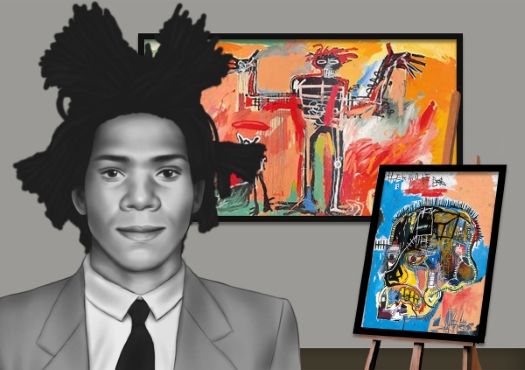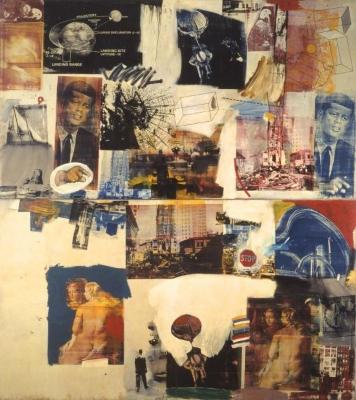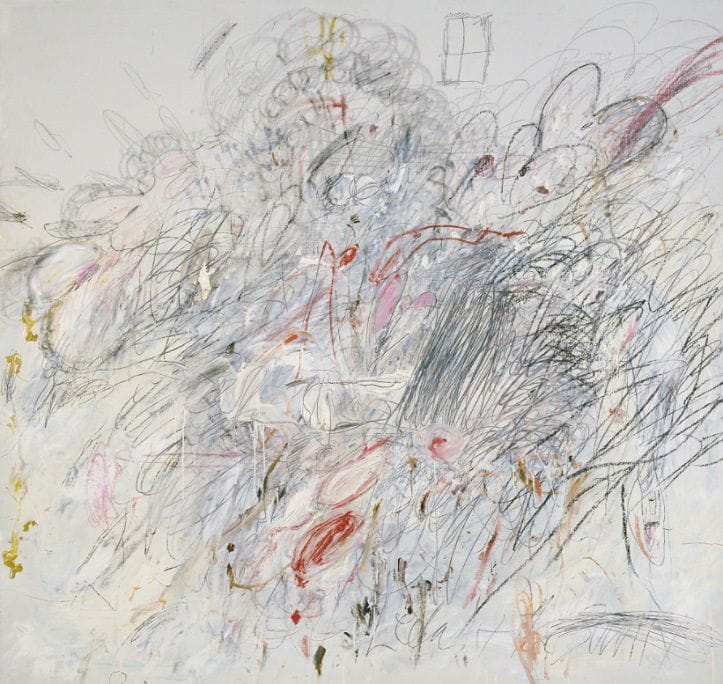Summary of Jean-Michel Basquiat
Jean-Michel Basquiat moved from graffiti artist to downtown punk scenester to celebrity art star in only the few short years of his career. This vertiginous rise took him from sleeping on the streets of New York City to being befriended by Andy Warhol and entering into the elite American art world as one of the most celebrated painters of the Neo-Expressionism art movement. Whilst Basquiat died at only 27 of a heroin overdose, he has now become indelibly associated with the surge in interest in downtown artists in New York during the 1980s.
His work explored his mixed African, Latinx, and American heritage through a visual vocabulary of personally resonant signs, symbols, and figures, and his art developed rapidly in scale, scope, and ambition as he moved from the street to the gallery. Much of his work referenced the distinction between wealth and poverty, and reflected his unique position as a working-class person of color within the celebrity art world. In the years following his death, the attention to (and value of) his work has steadily increased, with one painting even setting a new record in 2017 for the highest price paid for an American artist's work at auction.
Accomplishments
- Basquiat's work mixed together many different styles and techniques. His paintings often included words and text, his graffiti was expressive and often abstract, and his logos and iconography had a deep historical resonance. Despite his work's "unstudied" appearance, he very skillfully and purposefully brought together a host of disparate traditions, practices, and styles to create his signature visual collage.
- Many of his artworks reflect an opposition or tension between two poles - rich and poor, black and white, inner and outer experience. This tension and contrast reflected his mixed cultural heritage and experiences growing up and living within New York City and in America more generally.
- Basquiat's work is an example of how American artists of the 1980s began to reintroduce and privilege the human figure in their work after the domination of Minimalism and Conceptualism in the international art market. Basquiat and other Neo-Expressionist painters were seen as establishing a dialogue with the more distant tradition of 1950s Abstract Expressionism, and the earlier Expressionism from the beginning of the century.
- Basquiat's work is emblematic of the art world recognition of punk, graffiti, and counter-cultural practice that took place in the early 1980s. Understanding this context, and the interrelation of forms, movements, and scenes in the readjustment of the art world is essential to understanding the cultural environment in which Basquiat made work. Subcultural scenes, which were previously seen as oppositional to the conventional art market, were transformed by the critical embrace and popular celebration of their artists.
- For some critics, Basquiat's rapid rise to fame and equally swift and tragic death by drug overdose epitomizes and personifies the overtly commercial, and hyped-up international art scene of the mid-1980s. For many observers this period was a cultural phenomenon that corresponded negatively with the largely artificial bubble economy of the era, to the detriment of artists personally and the quality of artworks produced.
The Life of Jean-Michel Basquiat
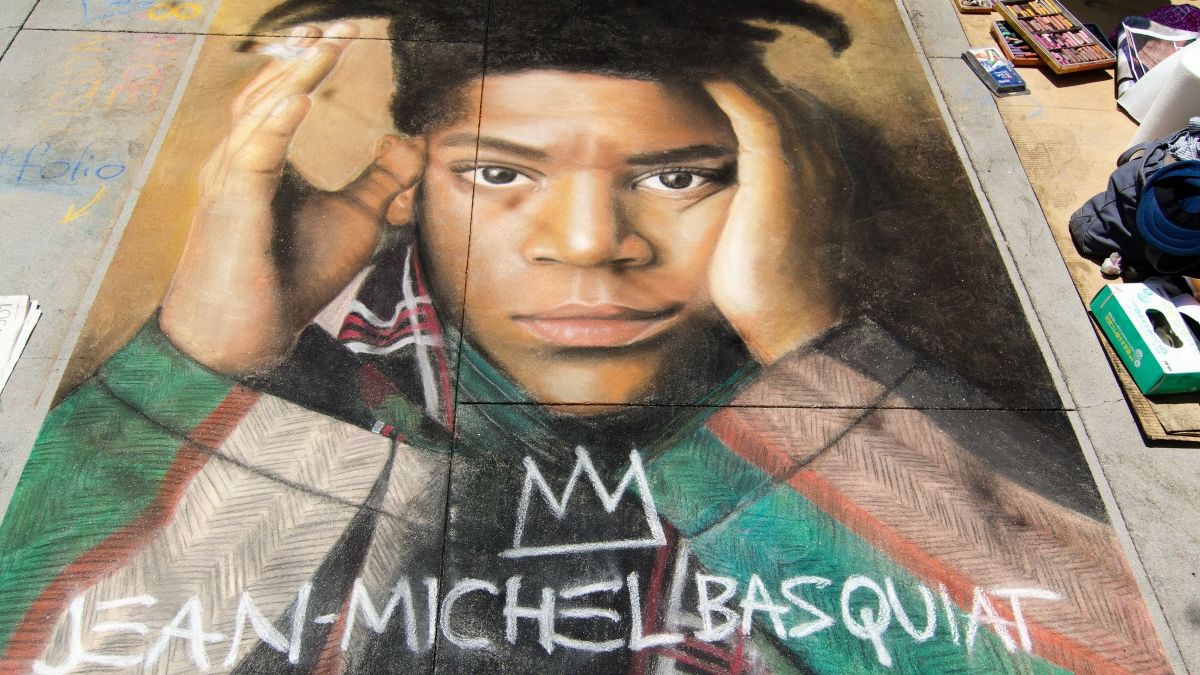
"I wanted to be a star, not a gallery mascot", Basquiat said. His life echoes this rise and struggle, and reveals the important dialogue between authenticity, representation, identity and recognition that is at the heart of understanding his work.
Important Art by Jean-Michel Basquiat
SAMO
Basquiat began painting graffiti in the late 1970s, often socializing and working alongside other artists of the subculture in the Bronx and Harlem. Graffiti artists often focused on figurative images (cartoonish pictures of animals, people and objects), as well as simple 'tags' - logos or names designed to be a trademark or calling card, which was where Basquiat also began. But Basquiat's graffiti quickly developed in a more abstract direction, with the "SAMO" tag origins quite mysterious and loaded with symbolism.
This particular black spray paint tag on a wall is emblematic of the SAMO works that Basquiat and his collaborator Al Diaz made between 1976 and 1980. Quickly applied to public spaces in the street and subway, the SAMO pieces conveyed short, sharp, and frequently anti-materialist messages to passersby. Usually seen as a sign of trespassing and vandalism, graffiti in the hands of Diaz and Basquiat became a tool of artistic "branding", and represents an important stage in the development of Basquiat's work.
The concept of SAMO, or "Same Old Shit", was developed during Basquiat's involvement with a drama project in New York, where he conceived a character that was devoted to selling a fake religion. Diaz and Basquiat applied the implicit critique embodied by this snake-oil-salesman figure to the commercial and corporate enterprises that they saw hawking goods in public spaces across their city. They initially began to spray paint the slogans that made up the works across subway trains as a way of "letting off steam" but, as Diaz remembers, they rapidly realized that it fulfilled an important role when they compared the work to more conventional graffiti tags. As Diaz says, "SAMO was like a refresher course because there was a statement being made".
After years of collaboration, Diaz and Basquiat chose to signify the end of their joint venture with the three-word announcement "SAMO IS DEAD". Carried out episodically in various cites as a piece of ephemeral graffiti art, the phrase surfaced repeatedly on gritty buildings, particularly those throughout Lower Manhattan, where Basquiat and his collaborators carried out much of their artistic activity.
Graffiti - Location unknown (New York City)
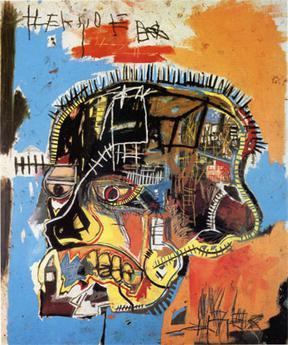
Untitled (Skull)
An example of Basquiat's early canvas-based work, Untitled (Skull) features a patchwork skull that seems almost a pictorial equivalent of the monster from Mary Shelley's Frankenstein - a constructed and sutured sum of incongruent parts. Suspended before a background that suggests aspects of the New York City subway system, the skull is at once a contemporary graffitist's riff on a long Western tradition of self-portraiture, and the "signature piece" of a streetwise bohemian. The expression on the skull-like face is downcast, with the rough stitches suggesting an unhappy combination of constituent parts. The colors used, which mix and swirl together, suggest bruising or wounds to the face, combining with the jagged lines to imply violence or its aftermath.
Basquiat's recent past as a curbside peddler, homeless person, and nightclub personality at the time that he created this piece are all equally stamped into the troubled three-quarter profile. Together these characteristics suggest that the piece becomes a world-weary icon of the displaced Puerto-Rican and Haitian immigrant Basquiat seemed to think himself doomed to remain, even while successfully navigating the newly gentrified streets of 1980s SoHo and the art market that took an interest in them.
Acrylic and mixed media on canvas - The Estate of Jean-Michel Basquiat
Untitled (Black Skull)
Like a page pulled cleanly from a daily artist's journal, this untitled canvas features an array of Basquiat's personal iconography and recurring symbols set against a black background and smeared patches of bright paint. A white skull juts from the center of the ebony composition, vividly recalling the revered painter's tradition of the memento mori - a reminder of the ephemeral nature of all life and the body's eventual, merciless degeneration. The bone to the right of the canvas could also be read as a phallus, suggesting the representation of Black male sexuality as threatening or primitive (particularly when positioned next to the arrow in the painting). Scales appear directly below the skull, perhaps representing the scales of justice and therefore implying the inequality in treatment of Black men by the police and justice system that is perpetuated to this day.
Boldy appropriating images commonly associated with rural African art - a skull, a bone, an arrow - Basquiat modernizes them with his Neo-Expressionist style of thickly applied paint, rapidly rendered subjects, and scrawled linear characters, all of which float loosely across the pictorial field, as though hallucinatory. Basquiat demonstrates in one concise "study" how he is able to carry on an ancient practice of painting "still life" all the while suggesting that the artist's work was relatively effortless, if not completely improvisatory, as in the performance of a jazz musician. Nevertheless, the density of the imagery and its loaded symbolism reveal Basquiat's skill and his ability in composition.
Acrylic, oil stick, and spray paint on canvas - The Estate of Jean-Michel Basquiat
Flexible
Flexible features two of Basquiat's most famous motifs: the griot and the venerable crown. An emaciated black figure stares out from the canvas towards the viewer, its arms creating a closed circuit in what may be a reference to spiritualized energy, a concept which appears in several works featuring the griot. The work also reflects Basquiat's development as an artist and is a synthesis of his influences, with the diagrammatic rendering of the figure's lungs and abdomen reminiscent of the young Basquiat's fascination with anatomical sketches from Gray's Anatomy.
Whilst its lack of distinguishing characteristics might imply an "Everyman", the specifically African ethnicity of the figure provides a clear reference to Basquiat's own identity and background. In its color palette and the particular rendering of the human figure through thin limbs and a large head, the influence of the shapes and forms of traditional West African art is apparent. Art historian and Basquiat collaborator Fred Hoffman writes that the image represents a tribal king, one whose "posture, with arms raised and interlocked above his head, conveys confidence and authority, attributes of his heroism. He seems to be crowning himself.
Given that the griot is traditionally a kind of wandering philosopher, street performer, and social commentator, it is possible that Basquiat saw himself taking up this role within the New York art world, which nurtured his artistic success but also swiftly exploited it for material profit. The image is painted on wooden slats, which Basquiat asked his assistants to remove from a fence that protected the boundary of his Los Angeles studio. By removing this barrier, Basquiat made the property open, and able to be traversed across freely, perhaps reflecting his empathy and personal experience of the limits of public space as a homeless person in New York.
Acrylic and oil paint stick on wood - Private Collection
Untitled (History of the Black People)
At the center of this painting, Basquiat depicts a yellow Egyptian boat being guided down the Nile River by the god Osiris. Two Nubian masks appear in the left of the image, under the word "NUBA", whilst graffiti-esque tags are scrawled over a silhouetted blackdog, reads "a dog guarding the pharaoh". Other text in the image includes "Memphis [Thebes] Tennessee" "sickle" (repeated several times in the central panel, and directly referencing slave trade), "Hemlock" (in the bottom right corner), "esclave slave esclave") superimposed over a silhouetted black human figure, as well as the Spanish phrases "El gran espectaculo" (along the top of the image), and "mujer" (next to a crudely drawn figure with circular breasts).
In this expansive early work, also referred to as The Nile, Basquiat reconstructs the epic history of his own ancestors' arrival on the American continent. This includes references to Egypt and the rest of Africa, as well as more local centers of African-American music in the Southern United States. Rife with visual and textual references to African history, the painting tackles a heady subject within Basquiat's trademark aesthetic. Art historian Andrea Frohne suggests that the painting "reclaims Egypt as African", attempting to undo the revisionist positioning of Ptolemaic Egypt as a precursor to Western Civilisation and instead emphasizing its African identity. This corresponds to attempts within the African-American community to reconnect with a specifically African heritage and history in the 1980s, which may have influenced Basquiat's development of the piece. Curator Dieter Buchhart asserts that "Basquiat was drawing and painting the Black experience in which any person from the African Diaspora could see themselves reflected and drawing attention to both their collective successes and struggles. Basquiat’s African-American men are usually not only ready to struggle but also intent on resistance."
Many of Basquiat's late-period works feature similar multi-panel paintings, in the tradition of Renaissance religious triptychs, and canvases with exposed stretcher bars. Often the surfaces of these pieces are virtually consumed by the density of the writing, collage, and varied imagery.
Acrylic paint and oil paint stick on panel - The Estate of Jean-Michel Basquiat
Arm and Hammer II
In this collaborative painting, Basquiat paints over Andy Warhol's trademark reproduction of a corporate logo, in this case for the Arm and Hammer brand of baking soda. Adjusting one of the two reproductions of the logo that appear in the painting to show a Black saxophonist instead of the flexing white arm, Basquiat frames the image with text which reads "Liberty 1955". The insertion of an image of Black creativity within an advertising logo may be an assertion of agency and reclamation of public space by Basquiat. It is also a visual reference to jazz, an African-American musical form that reached new heights of popularity in the 1950s, and an implicit acknowledgement of the repression of Black people that existed despite the music's success and incorporation into American identity.
Moreover, the insertion of an image of Black creativity within an advertising logo may be an assertion of agency and reclamation of public space by Basquiat. Typical of their collaboration, Arm and Hammer II demonstrates how Basquiat and Warhol would pass a work between them, like a game of chance happening, free association, and mutual inspiration. Warhol's characteristic employment of corporate logos and advertising copy as shorthand signs for the materialistic modern psyche is frequently overlaid by Basquiat's attempt to deface them in his freehand style, as though he were vainly raising his own fist at a largely invisible, insidious and monolithic monster in the form of corporate America.
Acrylic and silkscreen on canvas - Gallery Bruno Bischofberger AG
Ten Punching Bags (Last Supper)
Ten Punching Bags (Last Supper) is a collaboration between Basquiat and Andy Warhol, commissioned by Alexandre Iolas, the international art gallerist and collector. Basquiat painted each of ten white punching bags with an image of Jesus, as well as the word “Judge” repeated several times on each bag. The piece was originally intended to be displayed in Milan directly across the street from Leonardo da Vinci's Last Supper. Opposite the Renaissance masterpiece, Ten Punching Bags was to function, somewhat playfully, as a "call to arms" for contemporary art against all forms of ideological oppression.
Christian readings of the piece were generally (and perhaps surprisingly) very positive, the representation of Jesus as a punching bag corresponding to the concept that he took on the sins of human beings, receiving the punches that they might be free. Reverend Harold T. Lewis wrote that Basquiat's contribution to the work tied the role of Jesus to poverty, suggesting that the iconography both religious and secular added by Basquiat creates a situation where "Jesus the Judge himself is judged by the squalor of urban poverty".
Basquiat and Warhol suggested that this piece was among their favorite collaborations, as it represented an effective blend of their respective styles. Both artists made important contributions to the design. Warhol's influence is made clear by the careful color composition and physical installation, which is reminiscent of several of his iconic brand works. Basquiat's expressive renderings of Jesus and signature crown motifs disrupt the clean lines and organized placement however, much like graffiti disrupts the order of corporatized public space.
Acrylic and oil stick on punching bags - The Andy Warhol Museum
Riding with Death
Riding with Death is one of Basquiat's final paintings, and one which can easily be read as representing his inner turmoil and increasing conviction that the racist, classist, and corrupt nature of America in the 1980s was visible everywhere, including in the art world. Painted in the weeks before his death, the bleakness and sadness of the image and its title is only enhanced by the knowledge that the artist's life would come to an end far too soon shortly after its completion.
Less cluttered and visually dense than many of his earlier paintings, Riding with Death features a textured brown field onto which Basquiat has depicted an African figure riding a skeleton. The skeleton crawls on all fours towards the left-hand side of the image, whilst the rider, rendered in less detail than the bones on which they sit, writhes or flails its arms. The skull faces the viewer, its cartoonish proportions and broad expression suggesting the gestural graffiti that remained a core stylistic influence on Basquiat's painting. The simplicity of the background and the subject matter are also reminiscent of pre-historic cave art, as well as later African tribal art. The head of the African figure is indistinct, its features obscured by black scribbles apart from a single eye in its forehead.
The central figures, although simply framed, are loaded with symbolism. The pair suggest a nihilism or journey towards death that is made more poignant by Basquiat's dependence upon heroin and other drugs at the time of its painting. Although the African figure is riding the skeleton and could therefore be read as being in a position of dominance, the assertive positioning of the skeleton suggests instead that it is in control, perhaps dragging the rider to the far side of the frame. Coupled with the distinction in color between the two (a white skeleton and Black rider), this couple could be read as a metaphor for the repression and destruction of African societies by colonial powers, as well as the inequalities that existed within 1980s America for people of color. This work is an excellent example of the complex meanings Basquiat was able to communicate and suggest through a complex visual language regularly referred to by critics as "primitive" or "naïve". As this poignant image shows, Basquiat's work was in fact highly sophisticated and far more technically accomplished than is often credited.
Acrylic and crayon on canvas - Private Collection
Biography of Jean-Michel Basquiat
Childhood
Jean-Michel Basquiat was born in Brooklyn in 1960. His mother, Matilde Andradas was born also born in Brooklyn but to parents from Puerto Rico. His father, Gerard Basquiat, was an immigrant from Port-au-Prince, Haiti. As a result of this mixed heritage the young Jean-Michel was fluent in both French and Spanish as well as English. His early readings of French symbolist poetry in their original language would later be an influence on the artworks that he made as an adult. Basquiat displayed a talent for art in early childhood, learning to draw and paint with his mother's encouragement and often using supplies (such as paper) brought home from his father's job as an accountant. Together Basquiat and his mother attended many museum exhibitions in New York, and by the age of six Jean-Michel was enrolled as a Junior Member of the Brooklyn Museum. He was also a keen athlete, competing in track events at his school.
After being hit by a car while playing in the street at age 8, Basquiat underwent surgery for the removal of his spleen. This event led to his reading the famous medical and artistic treatise, Gray's Anatomy (originally published in 1858), which was given to him by his mother whilst he recovered. The sinewy bio-mechanical images of this text, along with the comic book art and cartoons that the young Basquiat enjoyed, would one day come to inform the graffiti-inscribed canvases for which he became known.
After his parents' divorce, Basquiat lived alone with his father, his mother having been determined unfit to care for him due to her mental health problems. Citing physical and emotional abuse, Basquiat eventually ran away from home and was adopted by a friend's family. Although he attended school sporadically in New York and Puerto Rico, where his father had attempted to move the family in 1974, he finally dropped out of Edward R. Murrow High School in Brooklyn in September 1978, at the age of 17.
Early Training
As Basquiat stated, "I never went to art school. I failed the art courses that I did take in school. I just looked at a lot of things. And that’s how I learnt about art, by looking at it". Basquiat's art was fundamentally rooted in the New York City graffiti scene of the 1970s. After becoming involved in an Upper West Side drama group called Family Life Theater he developed the character SAMO (an acronym for "Same Old Shit"), a man who tried to sell a fake religion to audiences. In 1976, he and an artist friend, Al Diaz, started spray-painting buildings in Lower Manhattan under this nom de plume. The SAMO pieces were largely text based, and communicated an anti-establishment, anti-religion, and anti-politics message. The text of these messages was accompanied by logos and imagery that would later feature in Basquiat's solo work, particularly the three-pointed crown.
The SAMO pieces soon received media attention from the counterculture press, most notably the Village Voice, a publication that documented art, culture, and music that saw itself as distinct from the mainstream. When Basquiat and Diaz had a disagreement and decided to stop working together, Basquiat ended the project with the terse message: SAMO IS DEAD. This message appeared on the facade of several SoHo art galleries and downtown buildings during 1980. After taking note of the declaration, Basquiat's friend and Street Art collaborator Keith Haring staged a mock wake for SAMO at Club 57, an underground nightclub in the East Village.
During this period Basquiat was frequently homeless and forced to sleep at friend's apartments or on park benches, supporting himself by panhandling, dealing drugs, and peddling hand-painted postcards and T-shirts. He frequented downtown clubs however, particularly the Mudd Club and Club 57, where he was known as part of the "baby crowd" of younger attendees (this group also included actor Vincent Gallo). Both clubs were popular hangouts for a new generation of visual artists and musicians, including Keith Haring, Kenny Scharf, movie director Jim Jarmusch and Ann Magnusson, all of whom became friends and occasional collaborators with Basquiat. Haring in particular was a notable rival as well as a friend, and the two are often remembered as competing with each other to improve the scope, scale, and ambition of their work. The two both gained recognition at similar points in their careers, progressing in parallel to reach the heights of art world stardom.
Due in part to his immersion in this downtown scene, Basquiat began to gain more opportunities to show his art, and became a key figure in the new downtown artistic movement. For example, he appeared as a nightclub DJ in Blondie's music video Rapture, cementing his cache as a figure within the "new wave" of cool music, art, and film emerging from the Lower East Side. During this time he also formed and performed with his band Gray. Basquiat was critical of the lack of people of color in the downtown scene, however, and in the late 1970s he also began spending time uptown with graffiti artists in the Bronx and Harlem.
After his work was included in the historic Times Square Show of June 1980, Basquiat's profile rose higher, and he had his first solo exhibition in 1982 at the Annina Nosei Gallery in SoHo. Rene Ricard's Artforum article, "The Radiant Child", of December 1981, solidified Basquiat's position as a rising star in the wider art world, as well as the conjunction between the uptown graffiti and downtown punk scenes his work represented. Basquiat's rise to wider recognition coincided with the arrival in New York of the German Neo-Expressionist movement, which provided a congenial forum for his own street-smart, curbside expressionism. Basquiat began exhibiting regularly alongside artists like Julian Schnabel and David Salle, all of whom were reacting, to one degree or another, against the recent art-historical dominance of Conceptualism and Minimalism. Neo-Expressionism marked the return of painting and the re-emergence of the human figure in contemporary art making. Images of the African Diaspora and classic Americana punctuated Basquiat's work at this time, some of which was featured at the prestigious Mary Boone Gallery in solo shows in the mid 1980s (Basquiat was later represented by art dealer and gallerist Larry Gagosian in Los Angeles).
Mature Period
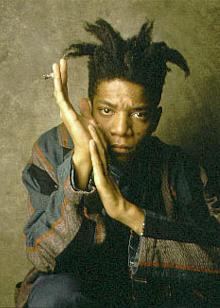
1982 was a significant year for Basquiat. He opened six solo shows in cities across the world, and became the youngest artist ever to be included in Documenta, the prestigious international contemporary art extravaganza held every five years in Kassel, Germany. During this time, Basquiat created some 200 art works and developed a signature motif: a heroic, crowned black oracle figure. The legendary jazz musician Dizzy Gillespie and boxers Sugar Ray Robinson, and Muhammad Ali were among Basquiat's inspirations for his work during this period. Sketchy and often abstract, the portraits captured the essence rather than the physical likeness of their subjects. The ferocity of Basquiat's technique, with slashes of paint and dynamic dashes of line, was intended to reveal what he saw as his subjects' inner self, their hidden feelings, and their deepest desires. These works also reinforced the intellect and passion of their subjects, rather than being fixated on the fetishized Black male body. Another epic figuration, based on the West African griot, also features heavily in this era of Basquiat's work. The griot propagated community history in West African culture through storytelling and song, and he was typically depicted by Basquiat with a grimace and squinting elliptical eyes fixed securely on the observer. Basquiat's artistic strategies and personal ascendency was in keeping with a wider Black Renaissance in the New York art world of the same era (exemplified by the widespread attention being given at the time to the work of artists such as Faith Ringgold and Jacob Lawrence).
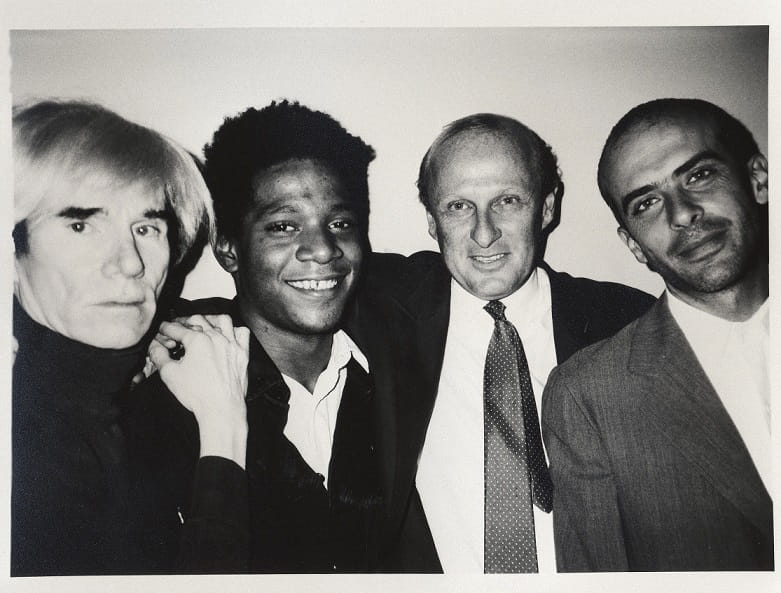
By the early 1980s, Basquiat had befriended Pop artist Andy Warhol, with whom he collaborated on a series of works from 1984 to 1986, such as Ten Punching Bags (Last Supper) (1985-86). Warhol would often paint first, then Basquiat would layer over his work. In 1985, a New York Times Magazine feature article declared Basquiat the hot young American artist of the 1980s. This relationship became the subject of friction between Basquiat and many of his downtown contemporaries, as it appeared to mark a new interest in the commercial dimension of the art market.
Warhol was also criticized for potential exploitation of a young and fashionable artist of color to boost his own credentials as current and relevant to the newly significant East Village scene. Broadly speaking, these collaborations were not well received by either audiences or critics, and are now often viewed as lesser works of both artists.
Perhaps as a result of the new-found fame and commercial pressure put upon his work, Basquiat was by this point of his life becoming increasingly addicted to both heroin and cocaine. Several friends linked this dependency to the stress of maintaining his career and the pressures of being a person of color in a predominantly white art world. Basquiat died of a heroin overdose in his apartment in 1988 at the age of 27.
The Legacy of Jean-Michel Basquiat
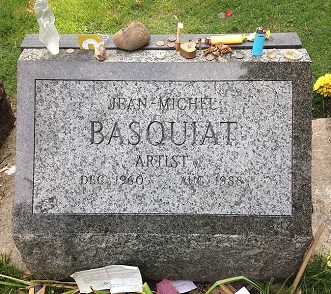
In his short life Jean-Michel Basquiat nonetheless came to play an important and historic role in the rise of the downtown cultural scene in New York and Neo-Expressionism more broadly. While the larger public latched on to the superficial exoticism of his work and were captivated by his overnight celebrity, his art, which has often been described inaccurately as "naif" and "ethnically gritty", held important connections to expressive precursors, such as Jean Dubuffet and Cy Twombly.
A product of the celebrity and commerce-obsessed culture of the 1980s, Basquiat and his work continue to serve for many observers as a metaphor for the dangers of artistic and social excess. Like the comic book superheroes that formed an early influence, Basquiat rocketed to fame and riches, and then, just as speedily, fall back to Earth, the victim of drug abuse and eventual overdose.
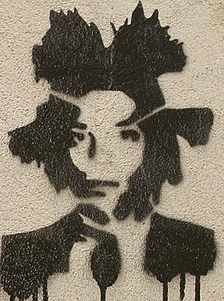
The recipient of posthumous retrospectives at the Brooklyn Museum (2005) and the Whitney Museum of American Art (1992), as well as the subject of numerous biographies and documentaries, including Jean-Michel Basquiat: The Radiant Child (2010), and Julian Schnabel's feature film, Basquiat (1996; starring former friend David Bowie as Andy Warhol), Basquiat and his counter-cultural legacy persist. In 2017, another film Boom for Real: The Late Teenage Years of Jean Michel Basquiat was released to critical acclaim, also inspiring an exhibition of the same title at the Barbican art gallery in London. His art remains a constant source of inspiration for contemporary artists, and his short life a constant source of interest and speculation for an art industry that thrives on biographical legend.
Alongside his friend and contemporary Keith Haring, Basquiat's art has come to stand in for that particular period of countercultural New York art. Both artists' work is frequently exhibited alongside the other's (most recently in the 2019 exhibition 'Keith Haring I Jean-Michel Basquiat: Crossing Lines' in Melbourne, Australia), and there have been a number of commercial licenses granted for the reproduction of several of his visual motifs. Recently this has included a range of graphic print shirts at Uniqlo displaying the work of both artists.
The rise in Basquiat's profile since his death has also pushed new artists to make work inspired by or even in direct reference to his work. This includes painters, graffiti and installation artists working within the gallery, but also musicians, poets and filmmakers. Visual artists influenced by Basquiat include David Hewitt, Scott Haley, Barb Sherin, and Mi Be in North America, as well as European and Asian artists such as David Joly, Mathieu Bernard-Martin, Mikael Teo, and Andrea Chisesi, all of whom cite his work as formative to their own development. Musicians such as Kojey Radical, Shabaka Hutchings, and Lex Amor have similarly praised his work as informing their own. These three musical artists in particular appeared alongside others on Untitled, a collaborative compilation released as a tribute to Basquiat in 2019 by London based record label The Vinyl Factory.
Influences and Connections

-
![Julian Schnabel]() Julian Schnabel
Julian Schnabel -
![Francesco Clemente]() Francesco Clemente
Francesco Clemente -
![Banksy]() Banksy
Banksy - Huma Bhabha
-
![Andy Warhol]() Andy Warhol
Andy Warhol -
![Keith Haring]() Keith Haring
Keith Haring -
![David Salle]() David Salle
David Salle -
![Kenny Scharf]() Kenny Scharf
Kenny Scharf - Ann Magnusson
Useful Resources on Jean-Michel Basquiat
- Basquiat: A Quick Killing in ArtOur PickBy Phoebe Hoban
- Warhol on Basquiat: The Iconic Relationship Told in Andy Warhol’s Words and PicturesOur PickBy Michael Dayton Hermann
- Basquiat’s "Defacement": The Untold StoryOur PickBy Chaédria LaBouvier, Nancy Spector, J. Faith Almiron, Greg Tate, Luc Sante, Carlo McCormick, Jeffrey Deitch, Kenny Scharf, Fred Braithwaite, and Michelle Shocked
- Basquiat: Art Masters SeriesBy Julian Voloj
- BasquiatBy Leonhard Emmerling
- Basquiat Before Basquiat: East 12th Street 1979-1980Our PickBy Nora Burnett Abrams
- Jean-Michel Basquiat. 40th Anniversary EditionOur PickBy Eleanor Nairne and Hans Werner Holzwarth
- BasquiatBy Marc Mayer
- Jean-Michel BasquiatBy Robert Farris Thompson and Renee Ricard
- Jean-Michel Basquiat: Now's the TimeBy Dieter Buchhart, Franklin Sirmans, Olivier Berggruen, Glenn O'Brien, and Christian Campbell
- Jean-Michel Basquiat: Now's the TimeBy Dieter Buchhart, Franklin Sirmans, Olivier Berggruen, Glenn O'Brien, and Christian Campbell
- The Jean-Michel Basquiat Reader: Writings, Interviews, and Critical ResponsesBy Jordana Moore Saggese
- Basquiat: Boom for RealOur PickBy Dieter Buchhart and Eleanor Nairne
- Writing the Future: Basquiat and the Hip-Hop GenerationOur PickBy J. Faith Almiron, Dakota DeVos, Hua Hsu, Carlo McCormick, Liz Munsell, and Greg Tate
- Basquiat and the BayouBy Franklin Sirmans, Robert Farris Thompson, and Robert OMeally
- Basquiat: By HimselfOur PickBy Dieter Buchhar, Anna Karina Hofbauer, A.K. Hofbauer, L. Jaffe, L. Rideal, D. Buchhart , B. Bischofsberger, N. Cullinan, and M. Halsband
- Jean-Michel Basquiat: 1981: the Studio of the StreetOur PickBy Diego Cortez
